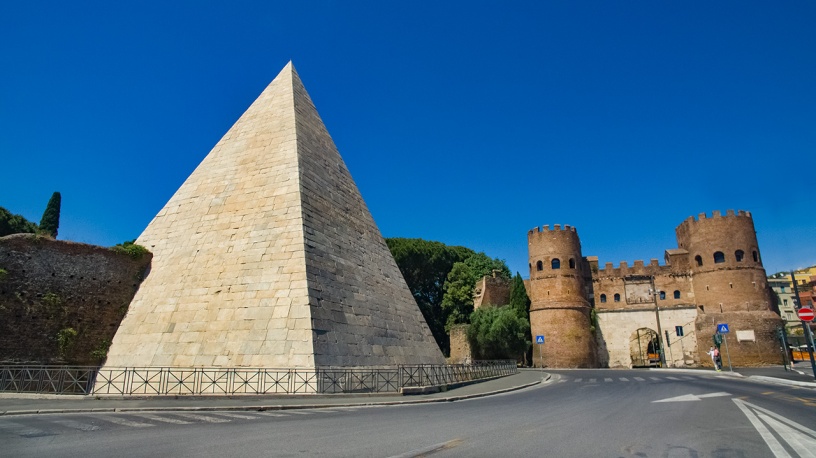Buongiorno and welcome to RomeCabs Rome Travel Blog! When you think of pyramids, your mind naturally drifts to the vast sands of Egypt, where the majestic pyramids of Giza rise against the desert sky. However, did you know that there is an Ancient Roman Pyramid in Rome? Yes! Pyramid of Cestius.
The city known for its grand Roman temples, iconic Colosseum, and bustling piazzas—also has its own pyramid. The Pyramid of Cestius, a striking structure in the heart of the Eternal City, stands as a vivid reminder of the cultural fusion between ancient Rome and Egypt. This intriguing monument not only sheds light on Rome’s fascination with Egypt but also symbolizes the deep political and cultural ties forged between these two great ancient civilizations.
Discover the Pyramid of Cestius in Rome
Egypt and Rome: A Historic Alliance
To fully appreciate why a pyramid was built in Rome, we must first understand the historical connection between Egypt and ancient Rome. Egypt, particularly under the reign of the legendary Cleopatra VII, played a pivotal role in the political landscape of the Mediterranean world. Cleopatra’s relationships with Julius Caesar and later with Mark Antony illustrate Egypt’s influence on Rome’s political sphere.
Cleopatra’s alliance with Caesar was not just one of romance, but also of political strategy. Egypt was an economic powerhouse, supplying Rome with vast amounts of grain. Egypt was Rome’s “bread basket”.
After Caesar’s assassination, Mark Antony and Cleopatra continued to strengthen ties, with Antony even relocating to Alexandria and forming a powerful political and romantic union with the Egyptian queen. Their bond, however, triggered a power struggle in Rome, culminating in the famous Battle of Actium in 31 BC, where their defeat at the hands of Octavian (later Augustus) led to Egypt’s incorporation into the Roman Empire.
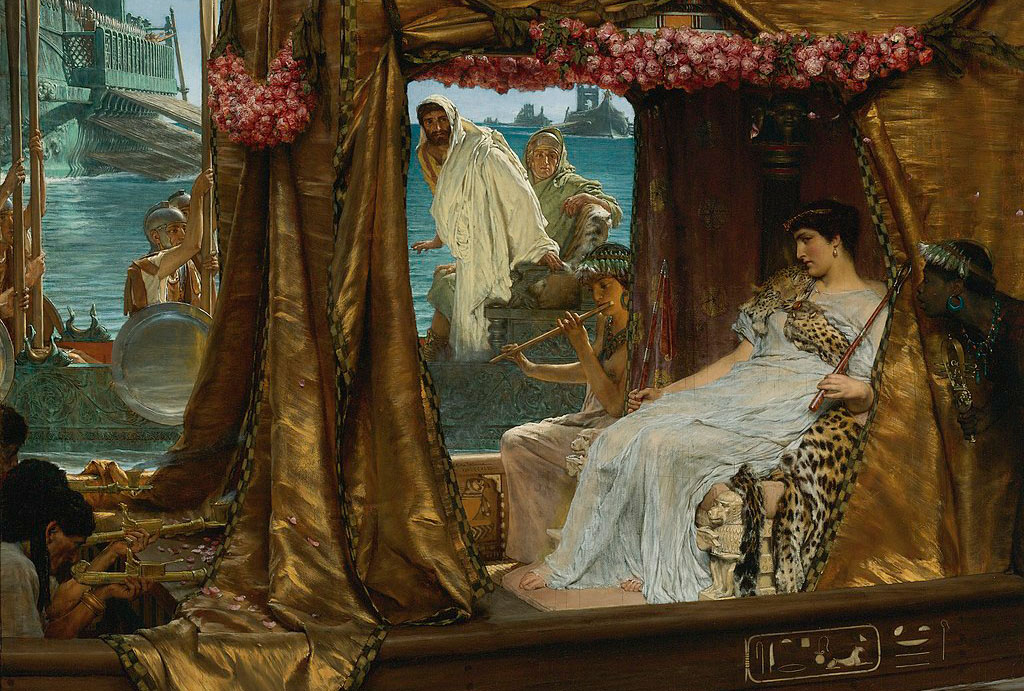
Egypt’s defeat marked the end of the Ptolemaic Kingdom, but it also initiated the beginning of a deep fascination in Rome with all things Egyptian. From religious practices to art and architecture, the mystique of Egypt captivated the Roman imagination.
Romans began incorporating Egyptian symbols into their cityscape, and this cultural absorption is most visibly symbolized by the obelisks and the Pyramid of Cestius that still stand in Rome today.
The Pyramid of Cestius, located near Porta San Paolo, is an extraordinary example of how Roman culture absorbed and adapted elements from the civilizations it encountered. Built around 12 BC, the pyramid was commissioned by Gaius Cestius, a Roman magistrate and member of the prestigious Epulones, a religious group tasked with overseeing public feasts and ceremonies.
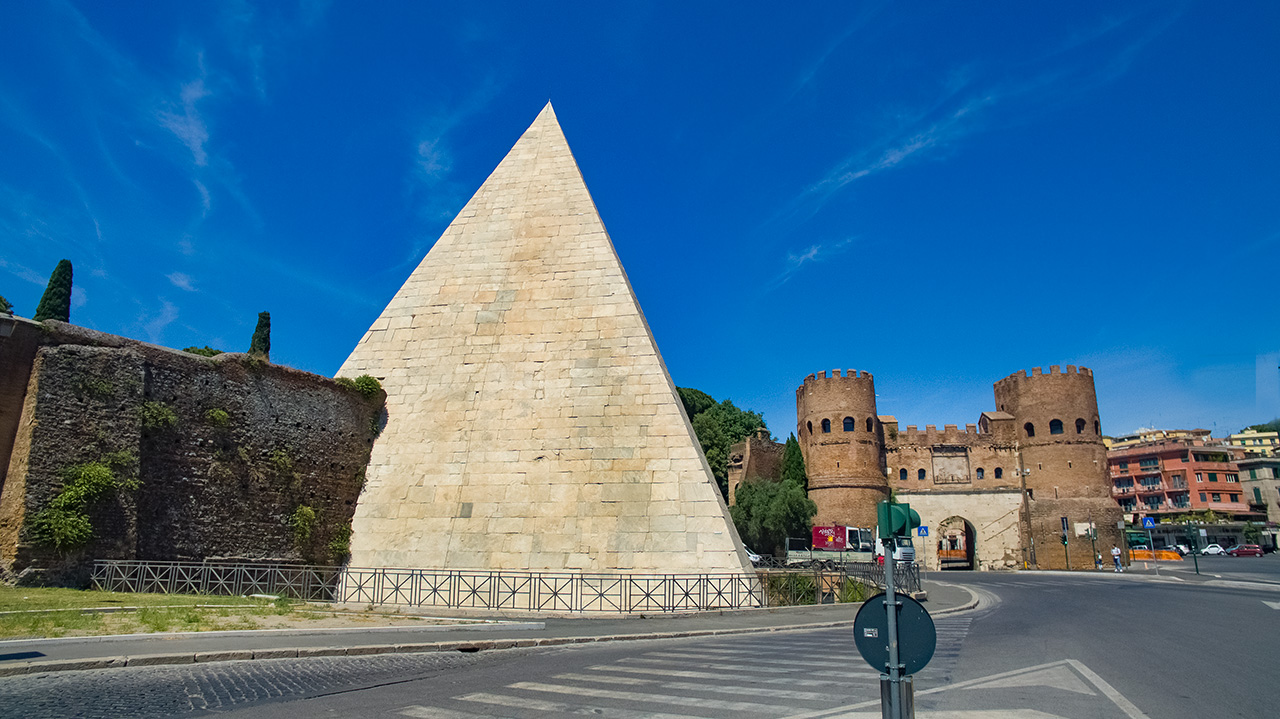
Standing 36 meters (118 feet) high and constructed from gleaming white Carrara marble, the Pyramid of Cestius is an imposing sight. Its base spans approximately 30 meters (98 feet) on each side, making it smaller than the famous pyramids of Giza, yet no less significant in its symbolism.
The choice to be buried in such a structure reflects how deeply Egyptian culture had become woven into Roman society following Egypt’s annexation by the Roman Empire in 30 BC. The fusion of styles—Egyptian pyramid shape combined with Roman frescoes inside—demonstrates the Romans’ admiration for Egypt’s ancient heritage and mysticism.
This design choice also coincided with a broader Roman craze for all things Egyptian. Egyptian obelisks were transported to Rome, and Egyptian-inspired art and religious practices became fashionable among Roman elites. Cestius’s tomb thus reflects both his personal admiration for Egyptian culture and the wider trend of Egyptian influence in Roman society following Egypt’s annexation.
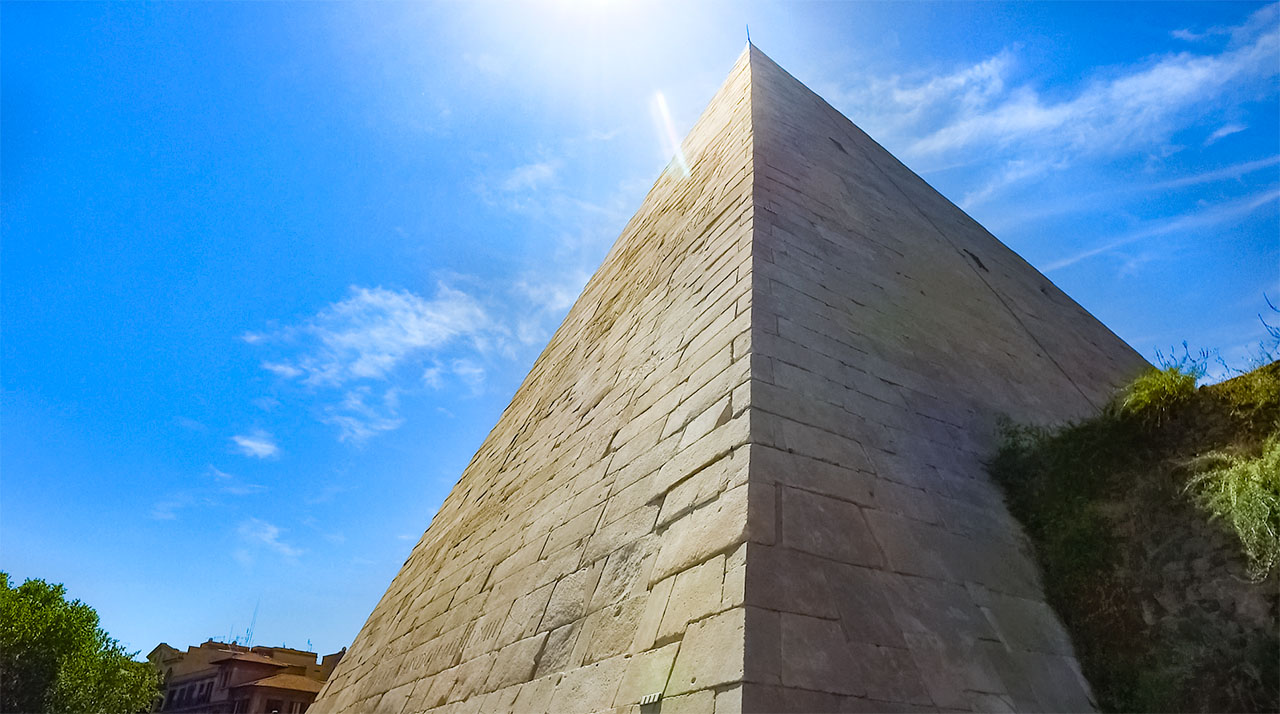
Inside the Pyramid of Cestius
The burial chamber inside the Pyramid of Cestius, though simple in design, once reflected the wealth and status of Gaius Cestius. Measuring 5.95 meters long, 4.10 meters wide, and 4.80 meters high, the rectangular, barrel-vaulted chamber was sealed upon construction, with no exterior entrance, signifying its sacred nature.
When opened in 1660, explorers found traces of vibrant frescoes, recorded by engraver Pietro Santo Bartoli. Though most of the artwork has faded, these frescoes once adorned the walls with typical Roman funerary themes. Sadly, the tomb had been plundered in antiquity, leaving little behind except for its architectural beauty, a testament to the blending of Roman and Egyptian styles. Despite its stripped interior, the pyramid stands as a symbol of Rome’s fascination with Egypt and its desire to honor the elite with grand, eternal monuments.
The Inscriptions on the Pyramid of Cestius
One of the most fascinating features of the Pyramid of Cestius is its series of inscriptions, carved into the structure’s northwestern and southeastern faces. These inscriptions provide valuable insights into the life of Gaius Cestius and the construction of the pyramid.
The primary inscription, found on both sides, reads:
G. CESTIVS L. F. POB. EPVLO PR. TR. PL. VII VIR EPVLONVM
“Gaius Cestius, son of Lucius, of the Pobilia voting tribe, member of the College of Epulones, praetor, tribune of the plebs, septemvir of the Epulones.”
This inscription highlights Cestius’s prestigious roles in Roman society. He was a member of the College of Epulones, one of the most important religious groups responsible for organizing public feasts in honor of the gods. His political career also included serving as a praetor and tribune of the plebs, two key positions in the Roman Republic.
Beneath the main inscription on the southeastern face, a secondary inscription details the circumstances of the pyramid’s construction:
OPVS APSOLVTVM EX TESTAMENTO DIEBVS CCCXXX ARBITRATV PONTI P. F. CLA. MELAE HEREDIS ET POTHI L
“The work was completed, in accordance with the will, in 330 days, by the decision of the heir Lucius Pontus Mela, son of Publius of the Claudia, and Pothus, freedman.”
This inscription reveals that the pyramid’s construction took 330 days and was supervised by Cestius’s heir, Lucius Pontus Mela, and his freedman, Pothus. It offers a rare glimpse into the precision with which Roman funerary projects were executed.
On the east face, a more modern inscription, dating from 1663, was added by Pope Alexander VII to commemorate restoration efforts. It reads:
INSTAVRATVM AN DOMINI MDCLXIII
“Restored in the Year of Our Lord 1663”
These inscriptions, alongside the architecture, not only provide a record of the life and status of Gaius Cestius but also offer a glimpse into the intersection of Roman and Egyptian culture. They speak to the Roman practice of honoring the deceased with monumental tombs and the fascination with foreign influences, especially from Egypt.
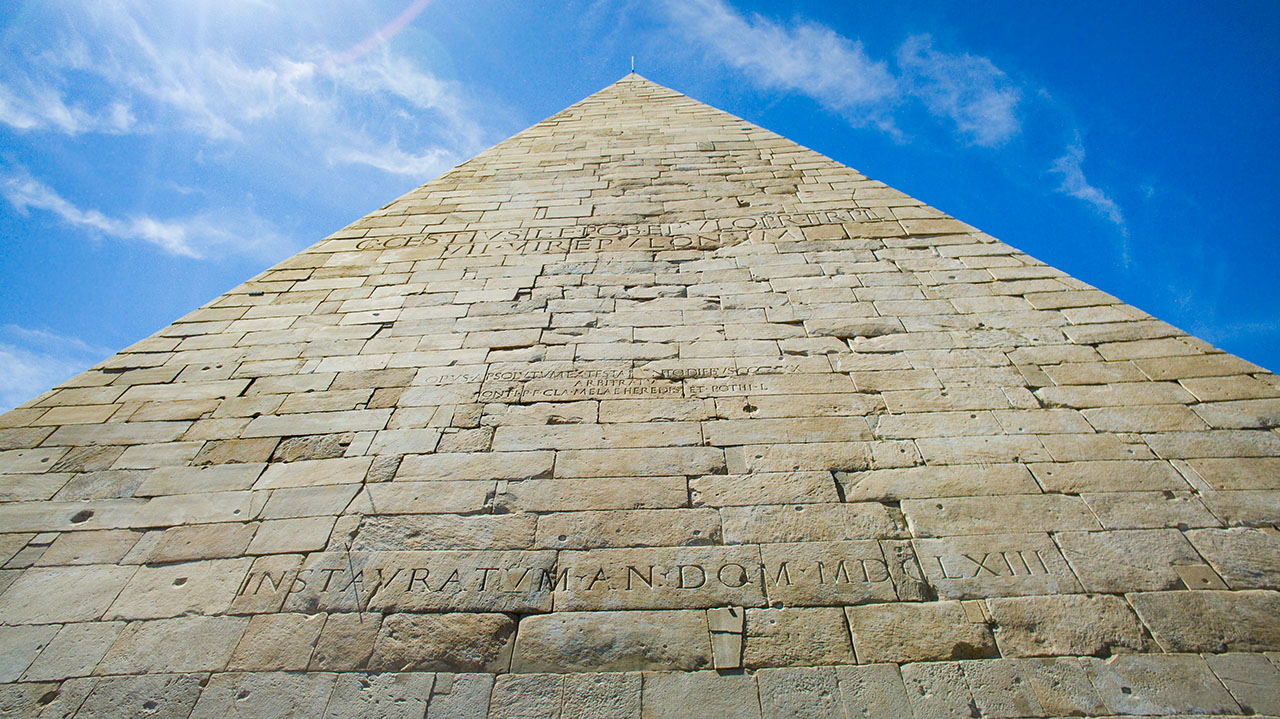
The Pyramids’ Incorporation into the Aurelian Walls and Later Rediscovery
During the construction of Rome’s Aurelian Walls between 271 and 275 AD, the pyramid was integrated into the city’s fortifications as a triangular bastion, a fine example of Roman ingenuity in repurposing existing structures. This incorporation likely saved the pyramid from decay, and it still forms part of the well-preserved stretch of walls near Porta San Paolo.
Over time, the pyramid’s origins were forgotten, and during the Middle Ages, Romans mistakenly believed it to be the tomb of Remus, one of the legendary founders of Rome. This belief persisted until Pope Alexander VII ordered excavations in the 1660s, which uncovered the original inscriptions and cleared away overgrown vegetation, restoring the pyramid’s true identity.
The Pyramid’s Enduring Influence
The Pyramid of Cestius became a popular attraction for travelers on the Grand Tour in the 18th and 19th centuries. Its distinct shape and historical significance captivated poets and artists alike.
Percy Bysshe Shelley referenced the pyramid in his elegy Adonaïs for John Keats, while Thomas Hardy pondered its meaning in his poem Rome: At the Pyramid of Cestius near the Graves of Shelley and Keats. These literary works, alongside the pyramid’s architectural influence, contributed to its lasting legacy as a symbol of the intersection between Egyptian mysticism and Roman grandeur.
Today, the Pyramid of Cestius stands as a remarkable monument to Rome’s cultural fusion and historical richness, inviting visitors to explore both its Roman and Egyptian influences.
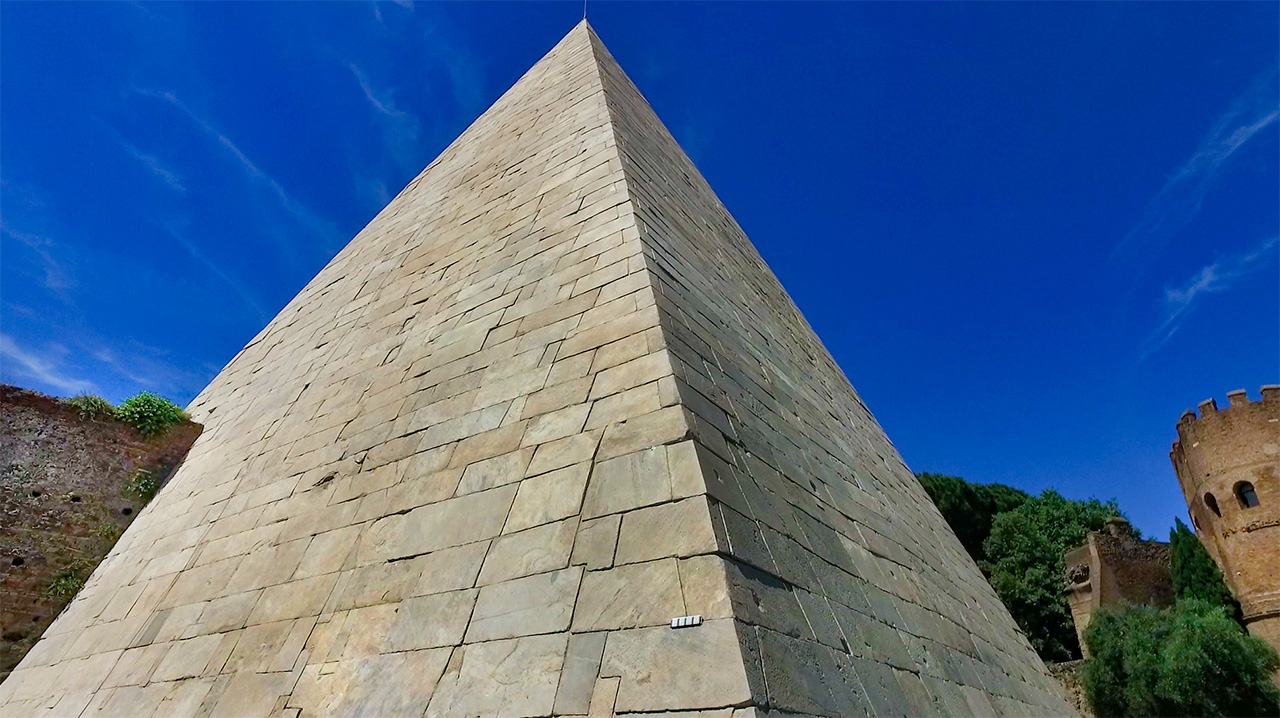
Rome also has Egyptian Obelisks!
In addition to the Pyramid of Cestius, Rome’s Egyptian connection is also evident in the numerous obelisks scattered across the city. These towering monuments, originally erected in Egypt to honor gods and kings, were brought to Rome after Egypt became a province of the Roman Empire. The Romans saw these obelisks as symbols of conquest and imperial power, and they became fashionable additions to Roman public spaces.
Today, Rome boasts more Egyptian obelisks than any other city in the world. The most famous stands in St. Peter’s Square, transported by Emperor Caligula in 37 AD. Other notable obelisks can be found in Piazza del Popolo, Piazza Navona, on top of the Fountain of the Pantheon, and Piazza di Montecitorio, serving as constant reminders of Egypt’s enduring influence on Roman culture.
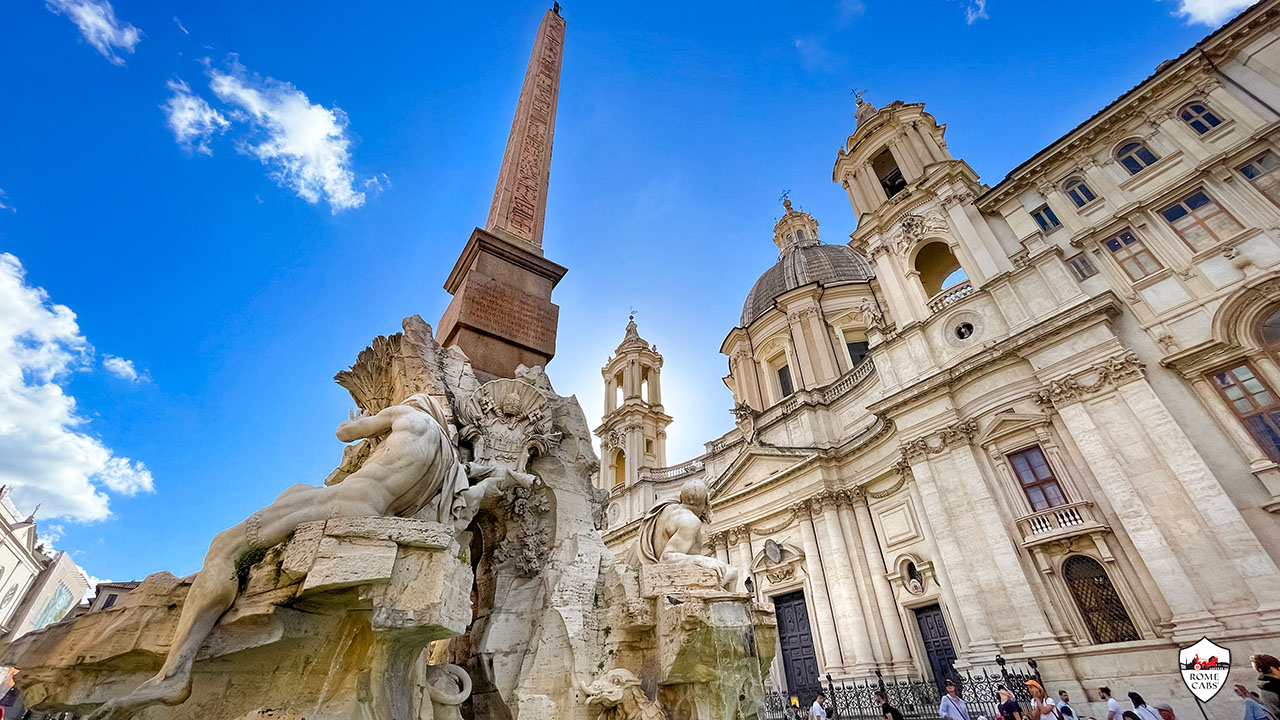
Ancient Rome’s Egyptian Legacy
The Pyramid of Cestius and the numerous Egyptian obelisks scattered across Rome serve as fascinating reminders of the Roman Empire’s far-reaching conquests and its openness to foreign influences. The Romans were adept at absorbing elements from the cultures they conquered, weaving them into their own society to create a diverse and dynamic civilization. Egyptian art, architecture, and religious practices found fertile ground in Rome, where they were reinterpreted and immortalized in iconic structures like the Pyramid of Cestius.
For modern visitors, the presence of an Egyptian pyramid in the heart of Rome might seem unexpected, but it is a vivid symbol of the cultural and political bonds that once united two of the ancient world’s greatest empires. Whether you’re strolling through the city in search of Roman ruins or marveling at Egyptian-inspired monuments, Rome offers a rich tapestry of history where every corner tells a story of cross-cultural exchange.
So, when you explore Rome’s ancient wonders, don’t forget to visit the Pyramid of Cestius—a hidden gem that connects the Eternal City with the eternal sands of Egypt.
Find RomeCabs online also on:
- RomeCabs FACEBOOK
- RomeCabs PINTEREST
- RomeCabs TWITTER
- RomeCabs INSTAGRAM
- RomeCabs FLICKR Photo Gallery
- RomeCabs Recommended on Cruise Critic
.
.
.
.
.
.
